- 0531-87887788

來源:http://www.tmmug.com/ 發布時間:2021-08-26
合金鋁板的電解著色具有良好的裝飾性,因此在國內外得到較廣泛應用,特別是在建筑鋁型材的表面處理生產中應用較為普遍。目前主要工藝是采用錫-鎳混合鹽電解著色,生產出的產品顏色以香檳色為主,相對于單鎳鹽著色,錫-鎳混合鹽電解著色的產品顏色光亮,色調飽滿;存在的主要問題是產品存在色差,鋁型材生產過程中的擠壓工藝和氧化著色工藝的不合理都會導致產品出現色差。
Electrolytic coloring of aluminum alloy plate has good decoration, so it is widely used at home and abroad, especially in the surface treatment production of architectural aluminum profiles. At present, the main process is electrolytic coloring with tin nickel mixed salt. The color of the product is mainly champagne. Compared with single nickel salt coloring, the color of electrolytic coloring with tin nickel mixed salt is bright and full; The main problem is the color difference of the product. The unreasonable extrusion process and oxidation coloring process in the production of aluminum profile will lead to the color difference of the product.
擠壓工藝對合金鋁板的氧化著色的影響主要是模具設計、5052鋁板擠壓溫度、擠壓速度、冷卻方式等對擠出型材表面狀態和組織均勻性的影響。模具設計應能使進料充分的揉合,否則容易出現亮(暗)帶缺陷,同一根型材上都可能出現分色;同時,模具狀態及型材表面的擠壓紋等也影響氧化著色。擠壓溫度、速度、冷卻方式及冷卻時間不同,使型材組織不均一,也會產生色差。

The influence of extrusion process on the oxidation coloring of alloy aluminum plate is mainly the influence of die design, 5052 aluminum plate extrusion temperature, extrusion speed and cooling mode on the surface state and microstructure uniformity of extruded profile. The mold design shall be able to make the feed fully knead, otherwise it is easy to have bright (dark) band defects, and color separation may occur on the same profile; At the same time, the die state and the extrusion lines on the profile surface also affect the oxidation coloring. Different extrusion temperature, speed, cooling mode and cooling time will lead to uneven structure and color difference.
陽極氧化對合金鋁板電解著色的色差有很重要的影響,尤其是在立式氧化線生產過程中很容易出現兩頭色,立式氧化槽深7.5m,上下槽液容易產生溫差,溫度對陽極氧化有重要的影響,溫度高,氧化槽液對氧化膜的溶解加劇,多孔型陽極氧化膜表面的孔徑會加大,反之,多孔型陽極氧化膜表面的孔徑較小。另外,溫度高,陽極氧化膜的孔隙率較高,反之較低。
Anodizing has a very important impact on the color difference of electrolytic coloring of alloy aluminum plate, especially in the production process of vertical oxidation line, it is easy to have two colors. The vertical oxidation tank is 7.5m deep, and the temperature difference between upper and lower tank liquid is easy to occur. Temperature has an important impact on anodizing. High temperature intensifies the dissolution of oxidation film by oxidation tank liquid, and the pore diameter of porous anodic oxidation film surface will increase, On the contrary, the pore size of porous anodic oxide film is small. In addition, the porosity of anodic oxide film is higher at high temperature, and vice versa.
合金鋁板電解著色主要是使著色液的金屬離子在氧化膜的微孔內的阻擋層的表面上進行電化學還原反應,使得著色液中的金屬離子沉積在陽極氧化膜孔的底部,對入射光發生散射而顯現出不同的顏色,微孔中沉積的物質越多,則顏色越深。在通過相同的電量的條件下,溫度高與低的部位上沉積等量的金屬或金屬化合物,對于孔隙率高和表面孔徑大的部位,平均每個孔的沉積物要少,5052鋁板所以其顏色相對較淺,反之顏色較深,從而造成了著色料兩頭色。合金鋁板在陽極氧化過程中,導電性對氧化膜有影響,也會引起著色料產生色差,該問題主要是在臥式生產線容易出現主要是由于氧化坯料在氧化前的上排過程中,鉗料不緊,導致個別料導電不好,從而使得其氧化膜相對有所不同,再經著色后,就會產生色差。
Electrolytic coloring of alloy aluminum plate is mainly to make the metal ions in the coloring solution carry out electrochemical reduction reaction on the surface of the barrier layer in the micropores of the oxide film, so that the metal ions in the coloring solution are deposited at the bottom of the anodic oxide film hole, scattering the incident light and showing different colors. The more substances deposited in the micropores, the darker the color. Under the condition of passing the same electric quantity, the same amount of metal or metal compound is deposited on the parts with high and low temperature. For the parts with high porosity and large surface pore diameter, the average sediment per hole is less. The color of 5052 aluminum plate is relatively light, on the contrary, the color is darker, resulting in two colors of coloring material. In the anodizing process of alloy aluminum plate, the conductivity has an impact on the oxide film and will also cause the color difference of coloring materials. This problem is mainly prone to occur in the horizontal production line. It is mainly due to the loose clamping during the upper row of oxidized blank before oxidation, resulting in poor conductivity of individual materials, which makes the oxide film relatively different. After coloring, the color difference will occur.